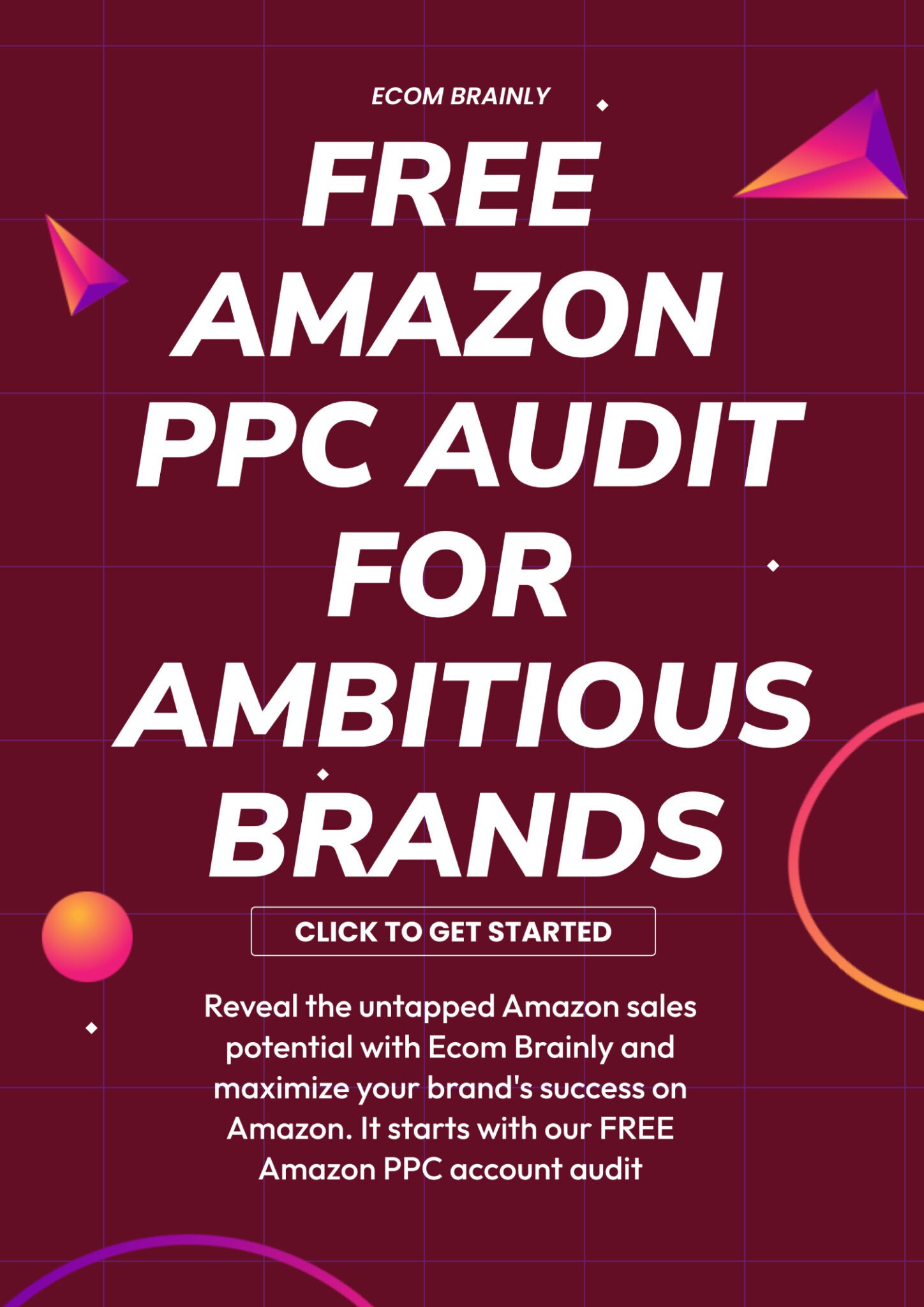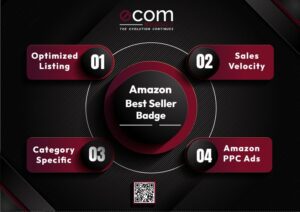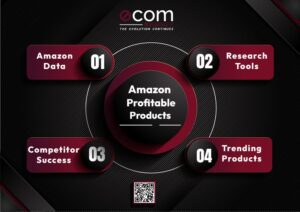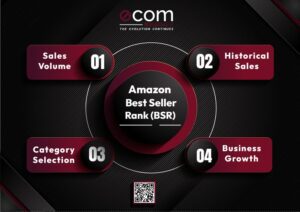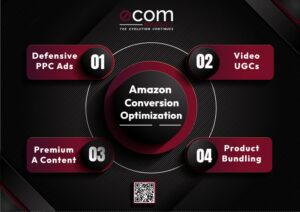Have a great time reading this blog.
Ready to see how our team can grow your Amazon brand? Click Here
.box {
position: relative;
padding: 15px;
font-size: 16px;
color: #62668A;
background-color: rgba(255, 100, 100, 0.05);
}
.box::before {
content: "";
position: absolute;
top: 0;
left: 0;
width: 100%;
height: 100%;
background-color: rgba(100, 15, 37, 0.05);
z-index: -1;
}
.text {
font-size: inherit;
}
.first-sentence {
font-size: 16px;
font-weight: bold;
}
.second-sentence {
font-size: 14px;
}
.text .link {
text-decoration: none;
color: #640F25;
font-size: 14px;
font-weight: 500;
}
/* Responsive font size for mobile devices */
@media (max-width: 767px) {
.box {
font-size: 15px; /* Reduce font size by 1 point for mobile */
}
.first-sentence {
font-size: 15px;
}
.second-sentence {
font-size: 13px;
}
.text .link {
font-size: 13px;
}
}
Have a great time reading this blog.
Ready to see how our team can grow your Amazon brand? Click Here
Advanced Amazon PPC Optimization Tips for Lower ACoS and Higher Sales
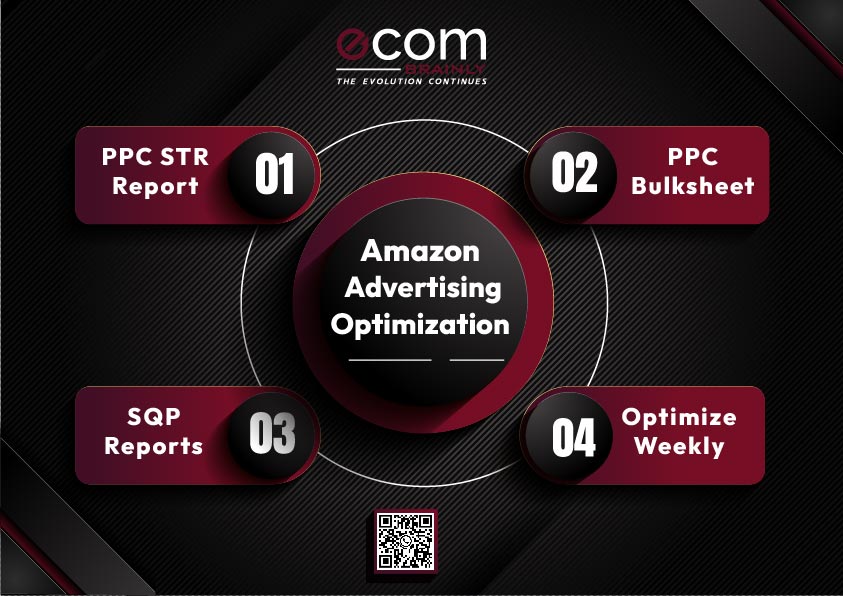
Amazon Pay-Per-Click (PPC) advertising has become an important tool for sellers aiming to broaden their customer reach and escalate their revenue on the Amazon platform.
With the marketplace teeming with potential customers, the competition among sellers is intense and relentless. The advent of Amazon FBA aggregators has further intensified this competition, with large brands and corporations investing heavily in advertising to scale their profits.
This has led to a significant increase in the average cost-per-click (CPC) from $0.70 in 2019 to $0.93 in 2023, highlighting the competitive and dynamic nature of Amazon’s advertising landscape.
In this highly competitive environment, it is crucial for sellers to track and optimize their Amazon ads to achieve the best possible outcomes.
This article goes deep into specific, actionable steps for optimizing Amazon advertising campaigns, enabling sellers to navigate the challenging market profitably.
From setting clear business and campaign goals to structuring campaigns effectively and optimizing product listings with relevant keywords, the article provides a comprehensive guide to mastering Amazon PPC optimization.
What is Amazon PPC Optimization?
Amazon PPC optimization is the strategic process of refining Amazon ad campaigns to enhance performance and achieve specific advertising goals.
This involves a meticulous evaluation and adjustment of campaign elements to ensure they align with the seller’s objectives, whether it’s boosting sales, increasing visibility, or improving profitability.
Sellers who dedicate time to optimizing their campaigns often witness better results, as opposed to those who rely solely on automated management tools.
While automation plays a crucial role in managing campaigns efficiently, a touch of human intervention can significantly accelerate the growth and success of these campaigns.
Key aspects of the optimization process include:
- Setting the Right PPC Goal: Identifying the primary objective for each product’s campaign, whether it’s to kickstart sales, enhance visibility, or target bottom-line profits.
- Campaign Kickoff: Starting with both automatic and manual campaigns to leverage Amazon’s algorithms for keyword discovery while maintaining control over keyword and product targeting.
- One-Time Optimization Activities: Implementing initial setup tasks such as setting Buy Box and pricing alerts to ensure campaigns run smoothly.
- Ongoing Optimization Activities: Engaging in daily, alternate day, and weekly activities to monitor budgets, optimize bids, refine targeting, and adjust strategies based on performance data.
Amazon PPC optimization is not a set-it-and-forget-it task but a dynamic process that requires regular attention and adjustments. By following a structured optimization strategy, sellers can significantly enhance their PPC performance, leading to increased sales, improved visibility, and better ROI on their advertising spend.
Why Need of Amazon PPC Optimization?
The necessity for Amazon PPC optimization arises from the inherent challenges and complexities of managing Amazon Sponsored Products Campaigns.
Despite the ease of setting up these campaigns, their continuous optimization is what truly differentiates successful sellers on the platform.
Reports indicate that 60% of Amazon sellers encounter difficulties with their PPC campaigns, often leading to increased Advertising Cost of Sales (ACoS) without a corresponding return on investment (ROI).
This underscores the critical need for effective Amazon PPC optimization strategies to enhance sales, visibility, and market share on Amazon.
Optimizing Amazon PPC campaigns is essential for several reasons:
Increased Sales and Visibility: Properly optimized PPC campaigns can significantly boost product visibility and sales, especially in a marketplace as competitive as Amazon. This is particularly vital for products facing stiff competition.
Efficient Ad Spend: Through the strategic use of keywords, including negative keywords, sellers can ensure their ad budget is spent on campaigns that target potential customers more likely to convert, thereby saving on ad spend and increasing ROI.
Achieving Target ACoS: Setting and achieving a target ACoS ensures that sellers get the best possible return on their advertising investment, making Amazon PPC optimization a crucial aspect of campaign management.
Data-Driven Decisions: Automatic campaigns serve as a valuable tool for gathering data and identifying new, high-performing keywords, which can then be utilized in manual campaigns for more targeted advertising efforts.
Dynamic Pricing: Adjusting prices based on demand, competition, and market conditions can optimize conversions, further highlighting the importance of a comprehensive approach to Amazon PPC optimization.
Amazon PPC Optimization Strategies
1. Campaign Goal Setting
Establishing a clear objective is paramount before going into Amazon advertising optimization. Whether your aim is to enhance visibility for specific keywords, reduce your Advertising Cost of Sales (ACoS) or Total Advertising Cost of Sales (TACoS), or bolster brand awareness, a well-defined goal is crucial.
It serves as a guiding light, enabling you to tailor your Amazon PPC optimization strategy effectively. Understanding your end goal allows for strategic planning, whether it’s market dominance, portfolio expansion, or connecting with a broader audience.
2. Keyword Research and Selection
The cornerstone of Amazon PPC optimization lies in detailed keyword research and selection. For instance, if you’re marketing a “Mylar Balloon,” opting for a broad term like “party balloons” might not yield the desired outcome initially. A more targeted approach, such as “Mylar Party Balloons,” could prove more beneficial.
This highlights the importance of selecting keywords that not only align with your product but also with the search intent of your potential customers. Utilizing tools like Helium10 Keyword Research tool can unveil high-performing keywords, ensuring your product listings are optimized to attract the right audience.
3. Campaign Structure
Adhering to a structured approach, such as the “One Ad Group Per Campaign” rule, is vital for maximizing Amazon PPC campaign optimization.
This method ensures a focused strategy on keyword selection, allowing for a balanced distribution of attention and budget across 5 to 10 keywords per campaign.
Incorporating both automatic and manual campaigns enriches your strategy, leveraging Amazon’s algorithmic keyword discovery in automatic campaigns while maintaining precise control in manual campaigns.
For a detailed discussion on Amazon PPC campaign structure and how it can impact your optimization efforts, be sure to check out our comprehensive guide here.
4. ACoS-Centric Approach:
While monitoring ACoS is a fundamental aspect of PPC optimization Amazon, it’s essential to recognize that ACoS should not be the sole KPI for measuring the success of your campaigns.
A more holistic metric to consider is Total Advertising Cost of Sales (TACoS), which provides a comprehensive view of your profitability by accounting for both organic and advertising sales.
This broader perspective can reveal a more accurate profitability picture, as it’s possible to be profitable with a 100% ACoS and at a loss with a 40% ACoS.
Therefore, your Amazon campaign optimization strategy should not be exclusively ACoS-centric. Instead, integrate TACoS into your evaluation to truly understand the profitability of your Amazon PPC efforts.
5. Amazon Search Terms Report for Optimization
The Amazon Search Term Report is an invaluable asset for Amazon PPC optimization, offering deep insights into how shoppers find and interact with your ads.
By analyzing this data, sellers can refine their PPC strategies, ensuring their campaigns are both cost-effective and high-performing.
Here’s a detailed exploration of how to utilize the Search Term Report for Amazon PPC campaign optimization.
5.1. Negative Targeting
Negative targeting is a critical strategy for minimizing wasted ad spend and improving campaign efficiency. By identifying and excluding irrelevant or underperforming search terms, you can ensure your ads are only shown to users with a genuine interest in your products.
Regularly review your Search Term Report to spot keywords that attract clicks but don’t convert, indicating they’re not aligned with your target audience’s intent.
Adding these terms to your negative keywords list helps refine your targeting, preserving your budget for more promising opportunities.
This practice is essential for maintaining a healthy Amazon PPC optimization strategy.
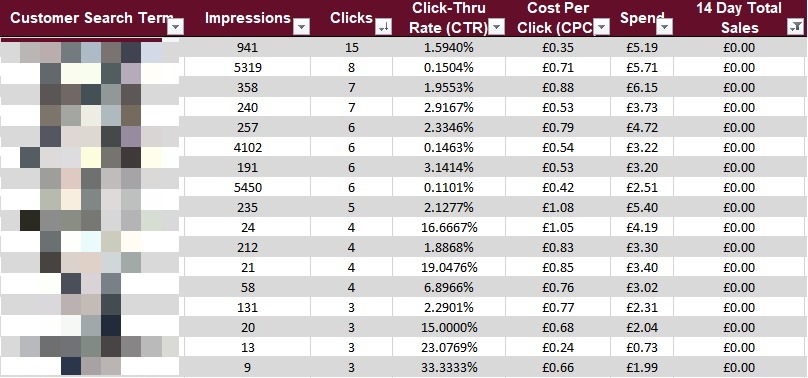
5.2. Cutting Down High ACoS Targets
High ACoS targets can drain your advertising budget without yielding proportional returns. The Search Term Report allows you to identify which keywords or search terms are resulting in high ACoS.
If certain keywords consistently underperform and contribute to an inflated ACoS, consider reducing your bids on these terms or pausing them altogether.
However, it’s important to align this decision with your overall campaign goals. For instance, if you’re in a product launch phase and prioritizing visibility over immediate ROI, a higher ACoS might be acceptable temporarily.
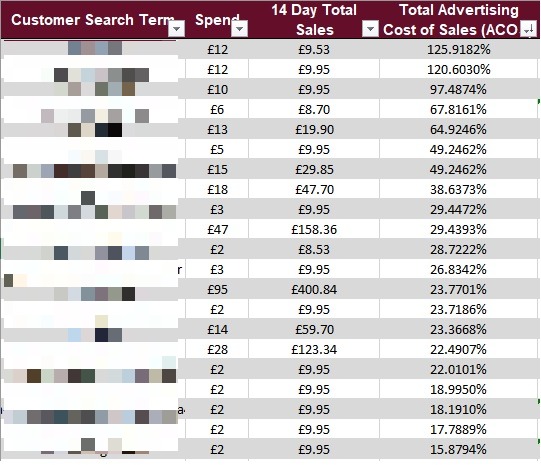
5.3. Optimizing Low ACoS Targets
Conversely, high converting low ACoS targets represent areas where your campaigns are performing efficiently, offering a good return on ad spend.
Use the Search Term Report to pinpoint these high-performing keywords and allocate more budget towards them. Increasing bids on these terms can enhance their visibility and drive more sales, contributing positively to your overall campaign performance.
This strategic reallocation of resources is a cornerstone of effective Amazon PPC campaign optimization, ensuring you capitalize on the most lucrative opportunities.
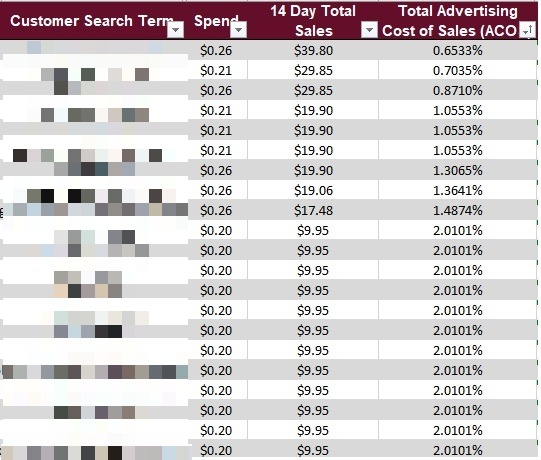
5.4. Optimize Low Impression Targets
Some targets may receive few to no impressions, indicating they’re not being seen by potential customers. This could be due to low bids or poor keyword relevance.
Analyzing the Search Term Report helps identify these low-visibility keywords. Incrementally increasing bids for these terms can boost their exposure.
However, it’s crucial to monitor these adjustments closely to ensure they don’t lead to an unjustifiable increase in ACoS. Balancing visibility and cost-efficiency is key to Amazon advertising optimization.
5.5. Keyword Migration
Keyword migration involves moving high-performing keywords across different match types to explore their potential in broader or more targeted contexts.
For example, a keyword performing well in an exact match could be tested in phrase or broad match types to assess its performance.
This strategy can uncover additional high-performing keywords and optimize your ad spend across different match types, a tactic that aligns with Amazon bid optimization principles.
5.6. Missing Search Terms
The Search Term Report can reveal gaps in your keyword strategy, showing high-intent search terms that aren’t currently targeted in your campaigns.
Identifying and adding these missing search terms to your campaigns can capture additional traffic and sales opportunities, enhancing your Amazon PPC optimization efforts.
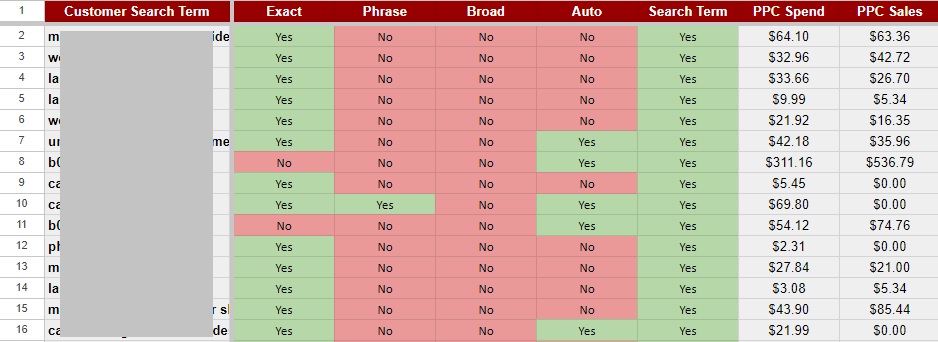
5.7. Branded vs. Non-Branded Terms
Distinguishing between branded and non-branded keywords in your PPC campaigns is crucial for accurate targeting and measurement.
Branded keywords typically have higher conversion rates but may not contribute to new customer acquisition. In contrast, non-branded keywords can drive broader visibility and attract new customers.
Use the Search Term Report to assess the performance of both types and allocate your budget accordingly, ensuring a balanced approach to Amazon campaign optimization.

5.8. Over-Reliance on Automatic Campaigns
While automatic campaigns are valuable for discovering new keywords, relying solely on them can lead to inefficiencies.
Use the insights from automatic campaigns to inform your manual campaign strategies, applying precise targeting and bid adjustments based on the data from the Search Term Report.
This balanced approach ensures you’re not only capturing a wide range of potential customers but also optimizing your ad spend for the best possible ROI.
5.9. Ranking Keywords Analysis
Analyzing the organic ranking of keywords within the Search Term Report allows you to prioritize your PPC efforts on keywords that have the potential to boost your product’s visibility in search results.
Targeting keywords where your product ranks just outside the top positions can be a strategic move to increase organic visibility and sales.
For instance, as illustrated in the image below, targeting “Customer Search Term 5,” which has an organic rank of “132,” may not be the most strategic approach for achieving your organic ranking goals.
A more effective strategy would be to focus on a search term that already enjoys a higher organic rank, ideally between positions 20 and 30. This approach is likely to yield better results and improve your visibility on Amazon.

6. Amazon Campaign Optimization with Bulksheet
Utilizing the Bulksheet in Amazon PPC campaigns is a sophisticated method to streamline and enhance your advertising efforts on a granular level. This approach allows for a comprehensive analysis and optimization across various components of your PPC strategy.
6.1. Campaigns Performance
The Bulk File provides a consolidated view of all your campaigns’ performance, encompassing key performance indicators (KPIs) such as impressions, clicks, spend, sales, and ACoS.
By applying pivot tables to this data, you can quickly identify trends, patterns, and areas needing improvement. This overview enables you to make informed decisions on budget allocation, bid adjustments, and strategic shifts to enhance campaign effectiveness.
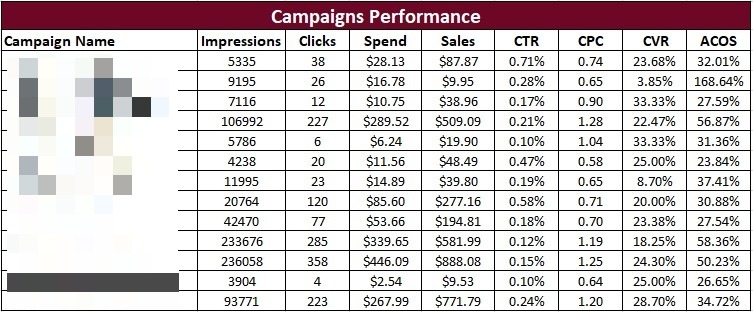
6.2. SKU Performance Analysis
Monitoring SKU performance is crucial for identifying which products are driving your Amazon business’s success.
The Bulksheet allows you to break down performance by individual SKUs, providing insights into their market share, growth trajectory, and contribution to overall campaign success.
By focusing on high-performing SKUs, you can allocate your advertising budget more effectively, ensuring that your investment promotes the products with the greatest potential for revenue generation.

6.3. Match Type Performance
Different keyword match types (Exact, Broad, Phrase, or Category targeting) play distinct roles in your Amazon PPC strategy.
Analyzing match type performance helps pinpoint which approach yields the best results for your campaigns.
This analysis can guide how you structure your bids and keyword strategy, optimizing for the match types that deliver the highest return on ad spend (ROAS).

6.4. Placement Performance
Evaluating the performance of different ad placements—Top of Search (TOS), Rest of Search (ROS), or Product Pages (PP)—is essential for optimizing bid strategies.
The Bulksheet analysis can reveal which placements are most effective for your campaigns, allowing you to adjust bids accordingly.
For instance, prioritizing TOS placement for Exact match campaigns might be beneficial, regardless of ACoS, due to the higher visibility and potential for conversion.

6.5. Auto vs. Manual Campaigns Performance
Comparing the performance of Automatic and Manual campaigns is critical for fine-tuning your PPC approach.
While Automatic campaigns can uncover valuable keywords and insights, Manual campaigns offer greater control over targeting and bids.
The Bulksheet analysis enables you to assess the effectiveness of each type, helping you decide where to focus your efforts and budget for optimal results.

7.Amazon PPC Optimization with Search Query Performance
7.1. Sales Funnel Analysis
The Amazon Search Query Performance (SQP) Report is a pivotal resource for understanding how customers interact with your ads on Amazon’s search engine.
This report sheds light on the sales funnel, from impressions to clicks, add-to-carts, and ultimately, purchases. Analyzing each stage of the funnel individually allows you to identify where improvements can be made, whether it’s increasing brand awareness or focusing on conversions.
Custom dashboards can be created to monitor these metrics over time, offering a dynamic view of your campaign’s health and effectiveness.

7.2. SQP Search Terms Analysis
Regularly tracking and analyzing your important search terms’ performance is fundamental to refining your Amazon PPC strategy.
By monitoring these terms weekly, you can adjust your campaigns to capitalize on what’s working and address any shortcomings.
Incorporating semi-relevant search terms into your titles and campaigns can also uncover new opportunities for visibility and sales, often at a lower cost due to less competition.

Conclusion
Amazon PPC can be a complex task to manage, but with the right strategies and insights, it’s possible to significantly enhance your campaign’s performance.
By focusing on detailed optimization techniques such as leveraging the Search Term Report, analyzing Bulksheets, and understanding the nuances of sales funnel dynamics, sellers can make informed decisions that drive sales and improve TACOS.
Remember, the key to PPC success lies in continuous testing, learning, and adapting.
Amazon Success with Ecom Brainly
Feeling overwhelmed by Amazon PPC? You’re not alone. At Ecom Brainly, we specialize in transforming complexity into clarity and spent into profits. Our team is ready to guide you through the difficulties of PPC optimization, ensuring your campaigns are not just running, but thriving.
Get the full potential of your products with a partner who understands your goals and knows how to achieve them. Whether you’re looking to enhance visibility, boost sales, or improve your ACoS, Ecom Brainly has the expertise and tools to make it happen.
Don’t let PPC challenges hold you back. Reach out to Ecom Brainly today, and take the first step towards maximizing your Amazon success. Together, we’ll turn your PPC efforts into measurable wins.
Share This Article

About Ecom Brainly
Ecom Brainly – A Full-Service Amazon agency that focuses on Sustainable Growth and Profitability for Our Partners (clients).
We been selling on Amazon since 2017 and has had to adapt for every change that Amazon has made along the way. Amazon is an ever changing marketplace and Ecom Brainly has his team ready to handle any and every challenge.
Is your brand having challenges with growth, profitability, advertising, reporting etc – If yes, please contact us today!


